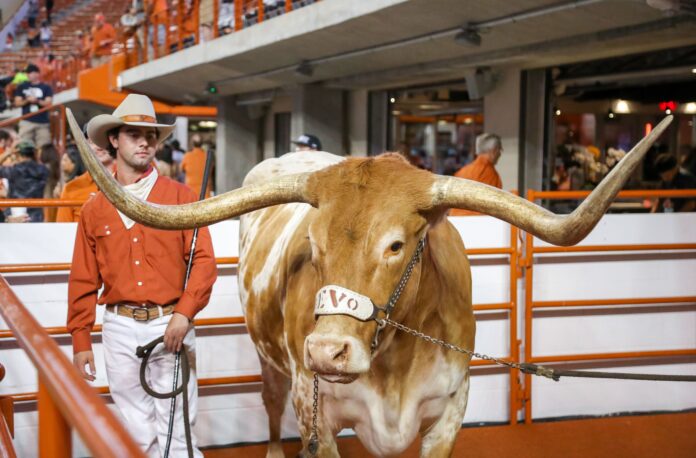College football is the ultimate celebration of pride and pageantry. Perhaps nothing better epitomizes this than the mascots that capture the very essence of a team. Few are as famous as the Texas Longhorns mascot, an instantaneously recognizable face of one of the most storied college football programs.
Who (or What) Is the Texas Longhorns Mascot?
The Texas mascot is a Texas Longhorn steer named Bevo, one of several “live mascots” in college football. The original Bevo was introduced by Stephen Pinckney in 1916, and there have been a total of 15 different Texas Longhorn steers used as the mascot since then.
While each college football mascot encapsulates the nickname or essence of the team, few are as key to the identity of a program as the Longhorns’ mascot.
Bevo’s distinctive burnt orange and white coloring provided the color scheme for what is now one of the most famous uniforms in college football. The distinctive shape of his horns helped form the school’s football logo. Meanwhile, “Hook ’em Horns,” and the accompanying hand gesture would never have existed without the $124 purchase of the original Bevo.
In fact, without that purchase, the Longhorns could have had a very different identity and mascot indeed. The original University of Texas mascot was a pit bull terrier that went by the name of “Pig,” which was the face of the program between 1914 and 1916.
MORE: Arch Manning Officially Signs With Texas Longhorns
He was named after Texas center Gus “Pig” Dittmar, who earned his nickname as he sliced through opposing defensive fronts like “a greased pig.” It was also noted that both Dittmar and the dog were bowlegged.
It is alleged that the students were more fond of Pig than Bevo, given the fact that he could be stroked and fussed in a way that a gigantic Longhorn could not. Capturing the essence of Texas football, it was also alleged that Pig would snarl at even the slightest mention of Texas A&M.
Bevo hasn’t been without his own fair share of aggressive acts during the over 100 years he’s been the Texas Longhorns mascot. Across the 15 different beasts behind Bevo, he has charged at cheerleaders, trampled across the Texas campus, bowled over the Baylor band, and famously skittled reporters as he tried to get to the Georgia mascot at the 2019 Sugar Bowl.
While 15 different steers have served as the Longhorns’ mascot, Bevo XIII is the longest serving to date. During his 16-year tenure that started in 1988, Texas won four conference titles, and Ricky Williams won the Heisman Trophy.
Why Is the Texas Mascot Called Bevo?
It was Ben Dyer who named Texas’ mascot Bevo. The burnt orange and tan steer was originally named simply “Bo,” but in 1916, following the Texas Thanksgiving Day game, Dyer proudly proclaimed:
“His name is Bevo, and long may he reign!”
Sadly for Longhorns fans, Dyer didn’t reign long enough himself to ever divulge why he chose the name. However, the name itself stuck, from 1916 to the modern day. The fact that Dyer didn’t ever get to tell the story of why he christened the Longhorns mascot Bevo, adds an element of mystique to the bovine beauty.
As is always the case when the true origin story is taken to the grave, multiple theories as to how the Texas Longhorns mascot came to get the name have arisen. Some — like the fact Dyer simply embellished the plural for beef or named Bevo after an alcohol-free beverage that shared the now icon Texas coloring — have an element of mundanity to them.
MORE: College Football Recruiting Rankings 2023
The third, while universally discredited, is much more in keeping with the traditions of college football. The story goes that students from Texas’ bitter rivals, Texas A&M, stole the original steer and emblazoned the poor animal with “13-0” — the result of the previous season’s encounter between the two rivals.
When the Longhorns mascot was recovered by Texas students, they attempted to cover up the branding by simply turning the one and three into a B, forming an E out of the hyphen, and inserting a “V” ahead of the “0” to make BEVO. While a much more entertaining — if not a little cruel — story on the naming of the Longhorns mascot, it was ultimately proven not to be true.

